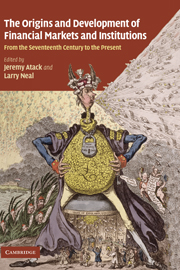 The Origins and Development of Financial Markets and Institutions
The Origins and Development of Financial Markets and Institutions Book contents
- Frontmatter
- Contents
- List of figures
- List of tables
- List of contributors
- Preface and acknowledgments
- 1 Financial innovations and crises: The view backwards from Northern Rock
- 2 An economic explanation of the early Bank of Amsterdam, debasement, bills of exchange and the emergence of the first central bank
- 3 With a view to hold: The emergence of institutional investors on the Amsterdam securities market during the seventeenth and eighteenth centuries
- 4 Was John Law's System a bubble? The Mississippi Bubble revisited
- 5 Sir George Caswall vs. the Duke of Portland: Financial contracts and litigation in the wake of the South Sea Bubble
- 6 The bell jar: Commercial interest rates between two revolutions, 1688–1789
- 7 Comparing the UK and US financial systems, 1790–1830
- 8 Natural experiments in financial reform in the nineteenth century: The Davis and Gallman analysis
- 9 Regulatory changes and the development of the US banking market, 1870–1914: A study of profit rates and risk in national banks
- 10 Anticipating the stock market crash of 1929: The view from the floor of the stock exchange
- 11 The development of “non-traditional” open market operations: Lessons from FDR's silver purchase program
- 12 The interwar shocks to US–Cuban trade relations: A view through sugar company stock price data
- 13 Central bank reaction functions during the inter-war gold standard: A view from the periphery
- 14 When do stock market booms occur? The macroeconomic and policy environments of twentieth century booms
- 15 Lessons from history for the twenty-first century
- Index
- References
6 - The bell jar: Commercial interest rates between two revolutions, 1688–1789
Published online by Cambridge University Press: 04 August 2010
- Frontmatter
- Contents
- List of figures
- List of tables
- List of contributors
- Preface and acknowledgments
- 1 Financial innovations and crises: The view backwards from Northern Rock
- 2 An economic explanation of the early Bank of Amsterdam, debasement, bills of exchange and the emergence of the first central bank
- 3 With a view to hold: The emergence of institutional investors on the Amsterdam securities market during the seventeenth and eighteenth centuries
- 4 Was John Law's System a bubble? The Mississippi Bubble revisited
- 5 Sir George Caswall vs. the Duke of Portland: Financial contracts and litigation in the wake of the South Sea Bubble
- 6 The bell jar: Commercial interest rates between two revolutions, 1688–1789
- 7 Comparing the UK and US financial systems, 1790–1830
- 8 Natural experiments in financial reform in the nineteenth century: The Davis and Gallman analysis
- 9 Regulatory changes and the development of the US banking market, 1870–1914: A study of profit rates and risk in national banks
- 10 Anticipating the stock market crash of 1929: The view from the floor of the stock exchange
- 11 The development of “non-traditional” open market operations: Lessons from FDR's silver purchase program
- 12 The interwar shocks to US–Cuban trade relations: A view through sugar company stock price data
- 13 Central bank reaction functions during the inter-war gold standard: A view from the periphery
- 14 When do stock market booms occur? The macroeconomic and policy environments of twentieth century booms
- 15 Lessons from history for the twenty-first century
- Index
- References
Summary
Le problème clef, c'est de savoir pour quelles raisons un secteur de la société d'hier que je n'hésite pas à qualifier de capitaliste, a vécu en système clos, voire enkysté; pourquoi il n'a pas pu essaimer facilement, conquérir la société entière.
(Fernand Braudel, Civilisation matérielle, économie et capitalisme, Volume 2: Les Jeux de l'échange), p. 289In our opening quotation, Fernand Braudel likens the development of early modern capitalism to a process occurring inside a “bell jar:” insulated from the rest of the economy and unable to expand to the whole society. The key question for him was to understand why, although the main elements of modern capitalism were already present in the Commercial Revolution, it took so long, until the Industrial Revolution, for capitalism to “conquer” society, and become the dominant organizational mode in the West.
Braudel's puzzle has much relevance for modern development economists. Recently, Hernando de Soto suggested that the bell jar metaphor fairly characterizes today's global financial system. During the past twenty-five years, he argues, many countries have formally opened up to global capital flows, but we still need to see the extreme efficiency displayed by New York's sophisticated financial markets benefit the poor rural areas of Peru, Niger, or India, where credit markets are shallow and interest rates remain high. The implication is that capitalism may thrive in certain areas without inducing rapid progress in other areas. This “Braudelian” puzzle is called by de Soto the “mystery of capital.”
- Type
- Chapter
- Information
- The Origins and Development of Financial Markets and InstitutionsFrom the Seventeenth Century to the Present, pp. 161 - 208Publisher: Cambridge University PressPrint publication year: 2009
References
- 23
- Cited by
